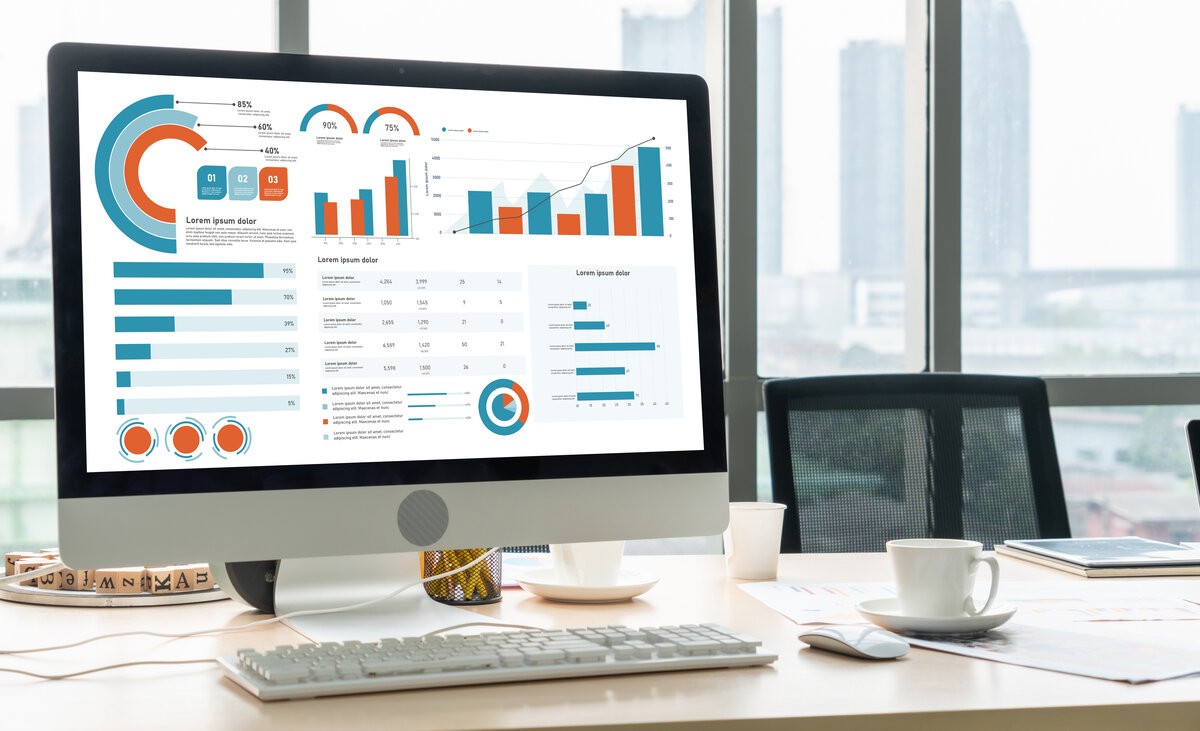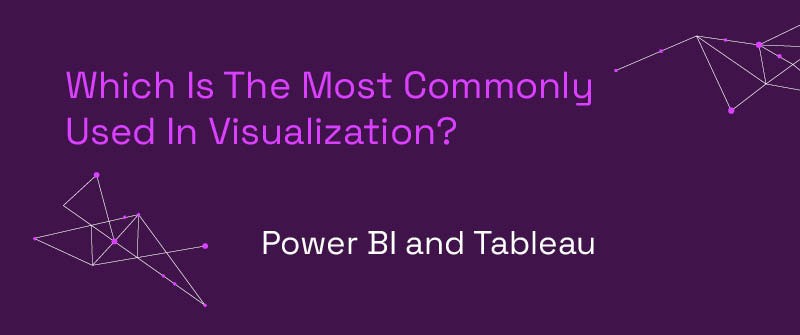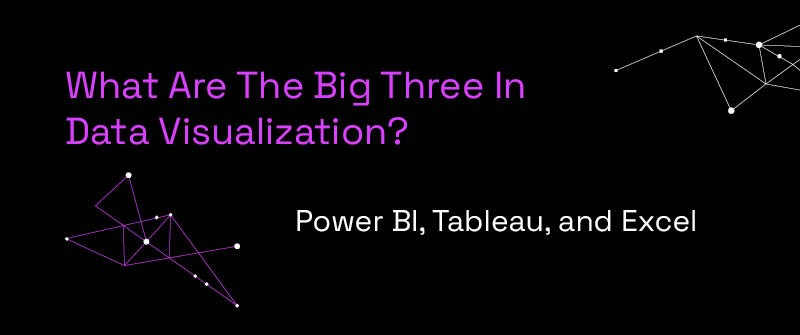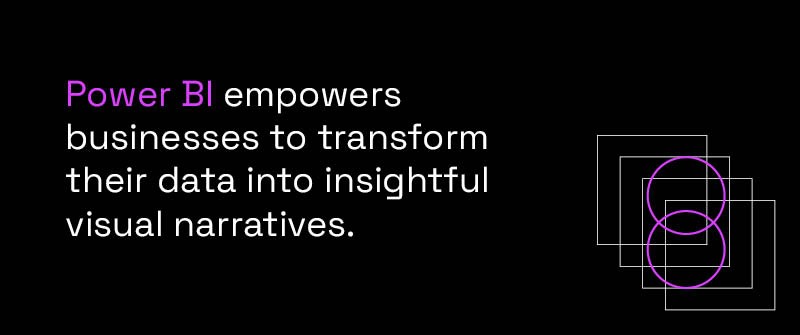
What Is The Best Data Visualization Tool?
In the realm of data visualization, the name Power BI quickly emerges as the frontrunner, solidifying its stance as the most widely used data visualization tool across various industries. Recognized for its robust features and extensive user engagement, Power BI not only leads in market share but also continues to grow its user base exponentially, making it the best data visualization tool for many organizations.
Power BI owes much of its popularity to its seamless integration with Microsoft’s suite of products, making it a convenient choice for businesses already embedded within the Microsoft ecosystem. This strategic alignment empowers businesses to meld their existing workflows with the visually intuitive and data-rich environment that Power BI offers, reinforcing its role in Business Intelligence Consulting Services.
The tool’s market dominance is further evidenced by recent statistics, which highlight a significant lead over competitors. Power BI’s ability to transform raw data into comprehensive, interactive dashboards and reports sets it apart, providing business leaders with a pivotal tool for decision-making.
Power BI also excels in data integration, allowing users to connect multiple data sources seamlessly for effective visualization and analysis. This capability enhances the overall business intelligence experience by consolidating information from various origins.
At P3 Adaptive, our Power BI consulting services ensure that organizations not only adopt Power BI but also maximize its potential. By tapping into our expertise, businesses can unlock deeper insights and foster a data-driven culture that propels growth and efficiency.
Which Is The Most Commonly Used In Visualization?
When discussing the most commonly used tools in data visualization, two names frequently arise: Power BI and Tableau. Both platforms have garnered significant followings due to their powerful features and capabilities, including their ability to connect and integrate various data sources, but there are distinctive attributes that often tip the scales in favor of one over the other.
The importance of data visualization techniques in both Power BI and Tableau cannot be overstated. They are essential for turning raw numbers into actionable insights.
What Is The Best Data Visualization Tool?
In the realm of data visualization, the name Power BI quickly emerges as the frontrunner, solidifying its stance as the most widely used data visualization tool across various industries. Recognized for its robust features and extensive user engagement, Power BI not only leads in market share but also continues to grow its user base exponentially, making it the best data visualization tool for many organizations.
Power BI owes much of its popularity to its seamless integration with Microsoft’s suite of products, making it a convenient choice for businesses already embedded within the Microsoft ecosystem. This strategic alignment empowers businesses to meld their existing workflows with the visually intuitive and data-rich environment that Power BI offers, reinforcing its role in Business Intelligence Consulting Services.
The tool’s market dominance is further evidenced by recent statistics, which highlight a significant lead over competitors. Power BI’s ability to transform raw data into comprehensive, interactive dashboards and reports sets it apart, providing business leaders with a pivotal tool for decision-making.
Power BI also excels in data integration, allowing users to connect multiple data sources seamlessly for effective visualization and analysis. This capability enhances the overall business intelligence experience by consolidating information from various origins.
At P3 Adaptive, our Power BI consulting services ensure that organizations not only adopt Power BI but also maximize its potential. By tapping into our expertise, businesses can unlock deeper insights and foster a data-driven culture that propels growth and efficiency.
Which Is The Most Commonly Used In Visualization?
When discussing the most commonly used tools in data visualization, two names frequently arise: Power BI and Tableau. Both platforms have garnered significant followings due to their powerful features and capabilities, including their ability to connect and integrate various data sources, but there are distinctive attributes that often tip the scales in favor of one over the other.
The importance of data visualization techniques in both Power BI and Tableau cannot be overstated.

Comparison with Tableau and Other Top Tools
Power BI and Tableau both offer robust visualization options, but Power BI’s integration with the Microsoft suite of products gives it a distinct advantage. Both Power BI and Tableau provide interactive visualizations, utilizing tools like Plotly and Highcharts, to enhance data presentation and user engagement. This seamless integration allows users to effortlessly transition between applications like Excel and PowerPoint, enhancing productivity and reducing the learning curve for businesses already invested in Microsoft’s ecosystem.
Advantages in Terms of Cost and Functionality
While Tableau is renowned for its comprehensive data visualization capabilities, Power BI stands out for its affordability. The cost-effectiveness of Power BI makes it accessible for small to medium-sized businesses, which might find Tableau’s pricing prohibitive. Beyond cost, Power BI’s use of familiar Windows-based navigation systems simplifies the user experience, ensuring that even those with minimal training can produce complex visualizations with relative ease.
Power BI also offers robust data analysis capabilities, integrating with various data sources to provide real-time insights and enhance decision-making within organizations.
Emphasis on Power BI’s Affordability
Power BI doesn’t just offer competitive pricing; it also provides a feature-rich platform that rivals its more expensive counterparts. With real-time data updates and interactive dashboards, Power BI goes beyond just data display. It empowers businesses to gain insights and make data-driven decisions swiftly. For companies seeking a balance of affordability, functionality, and efficiency, Power BI consistently emerges as the most practical option. Additionally, Power BI allows users to create data visualizations easily, making it accessible for both technical and non-technical users to generate insightful reports and dashboards.
P3 Adaptive specializes in maximizing these strengths of Power BI. Through our consulting services, we tailor solutions that align with your business’s unique needs. Our expertise ensures that you leverage the full range of Power BI’s capabilities, transforming your data into a strategic asset that drives growth and innovation.
What Are The Big Three In Data Visualization?
When discussing the leading tools for data visualization software, Power BI, Tableau, and Excel consistently emerge as the most prominent players. Each of these tools brings a unique set of strengths and use cases, particularly when bolstered by P3 Adaptive’s strategic analytics services.
These tools are adept at managing and visualizing complex data, transforming it into clear visual representations that facilitate better understanding, decision-making, and communication.

Power BI: Comprehensive and Integrated
Power BI is celebrated for its deep integration with Microsoft products, making it a favorite in corporate environments where seamless interaction with existing systems is vital. The data visualizations created using Power BI enable users to transform complex information into easily digestible formats. Its capacity for real-time analytics and intuitive interface demystifies complex datasets, turning them into actionable insights accessible at every organizational level. P3 Adaptive leverages Power BI’s capabilities to build dynamic, interactive dashboards that reflect real-world demands and scenarios.
Tableau: Leading in Interactivity
Tableau’s strength lies in its robust data visualization capabilities and interactive features, which are ideal for delving into data intricacies. It also excels in creating interactive data visualizations using Tableau. Its flexible solutions cater to a wide range of businesses looking to understand and visualize data without extensive IT interventions. Through P3 Adaptive’s consulting, Tableau is used to uncover hidden patterns and draw strategic insights that can transform business operations.
Excel: Ubiquitous and Versatile
Excel remains a cornerstone in data handling due to its widespread familiarity and versatility. It offers a variety of chart types, including line charts, which are essential for effectively representing data trends. Its ability to execute complex calculations through pivot tables and formulas makes it invaluable for dynamic analysis and reporting. At P3 Adaptive, Excel is not seen as outdated but as a powerful complement to other visualization tools, appropriately utilized to enhance data processing and reporting workflows.
P3 Adaptive’s Impact
P3 Adaptive stands out by employing these tools in tandem, creating a comprehensive analytics ecosystem that taps into each tool’s potential. The drag-and-drop features in these tools allow users to easily create customizable dashboards and visualizations, enhancing the overall experience for both novice and experienced users. By customizing solutions to fit specific business needs, P3 Adaptive ensures that companies do not just use data visualization tools but maximize their potential to foster informed decision-making and drive business growth.
Conclusion
Power BI consistently rises to the top when considering the best data visualization tools available, making it not just a favorite among users but a crucial asset in today’s competitive data landscape. Its seamless integration with Microsoft products, robust capabilities, and user-friendly interface position it a step above other tools.
By offering a comprehensive suite of features at a competitive price point, Power BI empowers businesses to transform their data into insightful visual narratives. Its dominance in the market is further validated by its rapidly growing user base, becoming the most widely used data visualization tool among business leaders and data professionals alike.

Embrace P3 Adaptive’s Expertise
As you navigate the decision-making journey, consider how P3 Adaptive can elevate your business data strategy. Our consulting services leverage industry-leading talents and cutting-edge technology to reveal actionable insights in just weeks. By transforming data into strategic assets, we empower your organization to conquer challenges and seize opportunities with confidence. Let P3 Adaptive pave the way to a more insightful and powerful business strategy.
Get in touch with a P3 team member